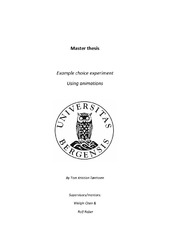Example choice experiment using animations. Using animations
Master thesis
Permanent lenke
http://hdl.handle.net/1956/6401Utgivelsesdato
2012-12-03Metadata
Vis full innførselSamlinger
Sammendrag
What are best practices in learning methods? That question has been and is still today still a much discussed topic. Some say learning by doing, some say read and memorize and some are not sure and try to think in new methods. One of these methods is a theory called the Example Choice theory. The purpose of this study is to investigate the effects of the Examples Choice theory in learning with the use of animations. By setting up an experiment we might be able to determine if the theory can enforce and improve learning outcomes. In the first part of the paper we will go through today's school and look at how students perform on test and look at different learning theories. The cognitive science also a part of this study even if it's not the focus in this paper it is important to understand learning. To find out if there was any hold in the theory we made an experiment. Our subjects in the experiment were 50 people in age-group 24-28 years. The subjects were randomly selected to go through a learning program with pre and post-tests to measure the outcome. The results in this study provide some support for the Example Choice theory but also raise some questions that need to be put under the loupe before making any final conclusions about the theory.
